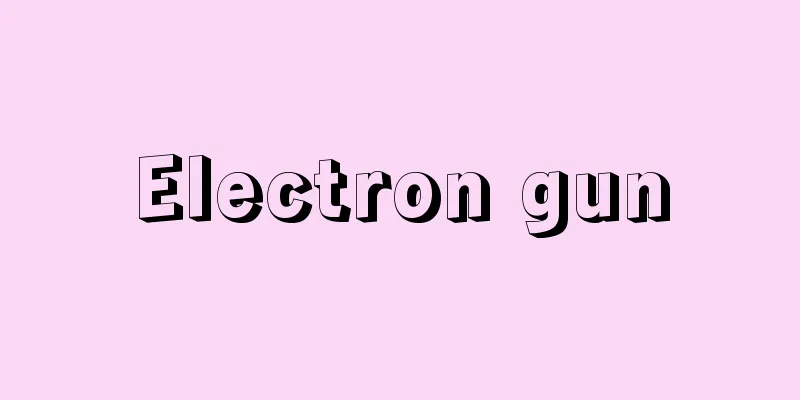Electron gun

|
A device that forms and emits an electron beam. It consists of a cathode that emits electrons and an electrode that accelerates and focuses the electrons to form them into a beam. Cathodes are usually thermionic emission types (hot cathodes), but field emission types (cold cathodes) are used for special applications such as high-resolution electron microscopes. Electron guns are available in two types: low current types under 1 milliampere, such as those used in cathode ray tubes and electron microscopes, and high current types used in microwave tubes. The electrons emitted from the cathode are given speed by a positive voltage, but are captured by the anode that applies the voltage. In addition, a force acts between the electrons that pushes them apart, so the electron beam tends to spread out. For this reason, electron guns for small currents use an electron lens that combines an anode with a hole, which gives energy to the electrons but allows them to pass without capturing them. An electron lens is made by applying a potential difference between two short, cylindrical metal electrodes (it can also be made using a magnetic field, but this becomes large and is usually done separately), and collects electrons at a focal point like an optical lens. In an electron gun for a television cathode ray tube, electrons are first extracted from the cathode by a triode-type electrode (excluding the control grid) or diode-type electrode. In the former, a relatively uniform (crossed) beam of electrons is extracted immediately after focusing, while in the latter, a sharp beam of electrons is extracted just before focusing, with little energy loss, through a small hole, and then guided to the main focusing electrode. The electron beam is then guided to a main focusing lens, which is made up of three cylindrical electrodes, with the center electrode at a voltage close to 0 volts (unipotential), or a main focusing lens made up of two electrodes (bipotential), where it is focused on the front of the tube. The anode that extracts the electron beam and the electrode in front of the main focusing lens form a prefocus lens. Unipotential focusing lenses produce a wide spot, but are less affected by fluctuations in the power supply voltage and produce a uniform image across the entire screen, so they are used in home television receivers. Bipotential lenses produce a sharp electron beam that is sharp in the center of the screen but tends to lose focus at the edges, so they are used in large television cathode ray tubes and for monitoring purposes. Many lenses improve image quality by using an electron extraction section suited to the purpose and a main focusing lens that appropriately combines unipotential and bipotential lenses. In hot cathode electron microscopes, an electron lens is formed by an electrode that surrounds the cathode in a Behnert cylinder named after its inventor, and an anode with a small hole. In cold cathode microscopes, an electron lens is used that combines two tapered anodes with small holes (carved into a cone shape). Electrons are extracted from the cold cathode through the sharp tip of a needle electrode, so the beam can be narrowed, but the electron flow is limited. Pierce-type electron guns are used in devices that do not require deflection but require a large electron current, such as traveling wave tubes, microwave tubes such as klystrons, and electron beam accelerators. In this electron gun, named after its developer, a conical electrode with the same potential as the cathode is placed on the cathode side, and together with the anode, an electric field is created that cancels the force that causes the electrons emitted from the cathode to expand, and the electrons are efficiently guided to the anode as a cylindrical beam parallel to the axis. [Michinori Iwata] [Reference item] | |Source: Shogakukan Encyclopedia Nipponica About Encyclopedia Nipponica Information | Legend |
|
電子ビームを形成・放射する装置。電子を放出する陰極と、電子を加速しながら集束してビームに成形する電極の組合せで構成される。陰極には熱電子放出型(熱陰極)が普通であるが、高分解能電子顕微鏡などの特殊用途には電界放射型(冷陰極)が用いられる。電子銃には、ブラウン管や電子顕微鏡などの1ミリアンペア程度以下の小電流用と、マイクロ波管などに用いる大電流用がある。 陰極から放出された電子は正電圧により速度が与えられるが、電圧を加える陽極にとらえられてしまう。また、電子間にはお互いに離れる力が働くので、電子ビームは広がろうとする。このため、小電流用の電子銃では、電子にエネルギーは与えるが電子をとらえないで通過させる、穴の開いた陽極を組み合わせた電子レンズを用いる。電子レンズは、短い円筒状の金属電極2個間に電位差を与えてつくられているが(磁界によってもできるが、大形になるので通常は別にしている)、光学レンズのように焦点に電子を集める。 テレビブラウン管用電子銃では、まず陰極から電子を引き出すための三極管型電極(制御格子は除く)または二極管型電極によって陰極から電子を取り出す。前者では焦点を結んだ直後の(交差した)比較的均質な、後者では電圧変動の影響は大きいが、焦点を結ぶ直前のエネルギー損失の少ない鋭い電子の束を小穴を通して主集束電極に導く。電子束はさらに3個の円筒電極のうち中央だけ0ボルト近くに電圧を低くした(ユニポテンシャル)主集束レンズ、または2個の電極で構成した(バイポテンシャル)主集束レンズに導いて管前面に焦点を結ばせている。電子束を引き出す陽極と主集束レンズの前段の電極はプリフォーカスレンズを構成する。 ユニポテンシャル集束レンズによるものはスポットは太めであるが、電源電圧変動の影響は少なく、画面全体に均質な像が得られるので家庭用受像機に用いられる。バイポテンシャルレンズによるものは電子ビームは尖鋭(せんえい)で、画面の中央はシャープであるが、周縁では焦点がぼけやすいので、大形テレビブラウン管とか監視用に用いられる。目的に応じた電子の引出し部と、ユニポテンシャルとバイポテンシャルを適宜組み合わせた主集束レンズとにより、画質を向上させたものも多い。 熱陰極型電子顕微鏡では、考案者の名を冠したベーネルト円筒で陰極を取り巻いた電極と、小孔をもつ陽極とで電子レンズを形成している。冷陰極型ではテーパーされた(円錐(えんすい)型に掘られた)小孔をもつ2個の陽極を組み合わせた電子レンズを用いている。冷陰極からは針状電極の鋭い先端から電子が取り出せるため、ビームは細く絞れるが電子流は限られる。 進行波管やクライストロンなどのマイクロ波管や電子線加速器など、偏向は必要はないが大電子流のほしい機器にはピアス型電子銃が用いられる。開発者名を冠したこの電子銃では、陰極側に陰極と等電位の円錐状の電極を配置して、陰極から放出された電子が広がろうという力を打ち消すような電場を陽極とともにつくり、電子を軸に平行な円柱状のビームとしてむだなく陽極へと導いている。 [岩田倫典] [参照項目] | |出典 小学館 日本大百科全書(ニッポニカ)日本大百科全書(ニッポニカ)について 情報 | 凡例 |
<<: International standards for information technology
Recommend
Yellow baldness - Yellow baldness
...Red and white clay are used for the clay body,...
Steppe Climate
It is the second driest climate (Köppen's BS ...
Tokura Pass
This pass is located on the border between Shiso ...
"Kyoya Collar Store" - Kyoya Collar Store
...Next, he made a film adaptation of Tolstoy'...
Costa, AAda (English spelling) CostaAAda
In response, in September 1836, a radical group (...
The Okuma Cabinet
→ The Shigenobu Okuma Cabinet Source : Heibonsha E...
Hassell, O.
…Proof of the structure of cyclohexane itself was...
Pitot tube
A type of current meter created in 1728 by the Fr...
Basic Subjects
…The term was coined by Friedrich Wilhelm Jähns (...
World Agricultural Census - World Agricultural Census (English name)
A census usually means a general, multi-item surve...
Imaama (turban) - Imaama
…Among them, the Sikhs known as the Lion Sect fol...
Fundamental group
The fundamental group, along with the homology gro...
Kintai Gakufu - Kintai Gakufu
…As the phrase goes, “Chinese classics, Tang poet...
Emblemata
…Also, Cranach’s mass-produced “The Mismatched Co...
Private property system - Privateigentum System (German)
Private ownership of property is institutionally ...









